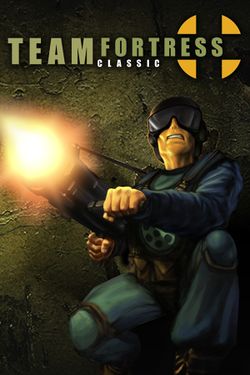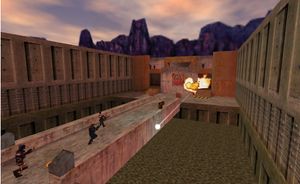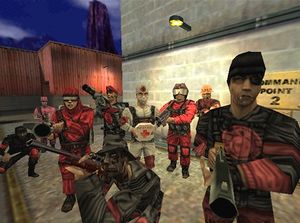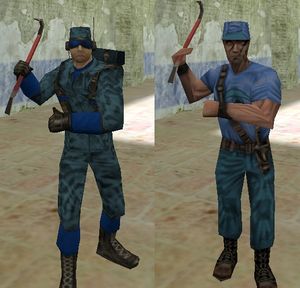Team Fortress Classic
| Team Fortress Classic | |
|---|---|

| |
| Basic Information | |
| Released: |
April 1, 1999
|
| Developer: | |
| Publisher: |
Sierra Studios, Valve |
| Distributor: | |
| Engine: | |
| Genre: | |
| Mode: | |
| Designers: | |
| Ratings: |
ESRB: Mature 17+ |
| Platforms: |
Microsoft Windows |
| Requirements: |
800 MHz processor |
Team Fortress Classic (TFC), also known as Team Fortress 1.5, is a title in the Team Fortress series of games.
Team Fortress Classic is a class-based multiplayer online first-person shooter video game developed by Valve and published by Sierra Studios. A port of the Team Fortress mod for Quake/QuakeWorld, Team Fortress Classic was originally released for Windows on April 1, 1999, as a mod for Half-Life and based on the Half-Life Engine (GoldSource Engine). A standalone version was later released on January 16, 2003. The development of Team Fortress Classic was led by John Cook and Robin Walker, two of the three designers from Team Fortress.[1]
The game itself involves a number of teams, each with access to ten classes, competing in a variety of modes such as Capture the Flag, Control Points, and Escort. In June 2000, the game underwent a significant upgrade, adding new player character models and game modes. As of 2003, the game was one of the ten most played Half-Life mods according to GameSpy.[2] Today, as with its predecessor, Quake Team Fortress, it is not very active, and as such, there are few servers with humans on them, and bots prosper in the majority of servers. Your server browser can pick up at most 100 or more servers.
Contents
Development
Before Team Fortress Classic, there was Team Fortress – a 1996 mod for Quake/QuakeWorld. After that success, Team Fortress Software wanted to begin work on Team Fortress 2 as a mod based on the Quake II engine, but later joined Valve and ported Team Fortress as a mod for Half-Life called Team Fortress Classic, released on April 1, 1999. Despite the company's 1998 statement that Team Fortress 2: Brotherhood of Arms would be released "soon", the game remained in development in one form or another for eight years until its release on October 10, 2007, and had been on Wired magazine's top ten vaporware list every year since 2001. The designers of Team Fortress had been tasked with developing Team Fortress 2 on the Half-Life 1 Engine (Gold Source Engine), but they instead remade Team Fortress using that engine to help demonstrate its moddability.
Following Team Fortress Classic's release in 1999, Valve introduced various changes into the game. The updates tweaked the game's balance and on occasion added new content, such as new levels. A particularly large update was released on June 8, 2000, introducing several new levels and game modes, a new menu interface, new player models, and optimizing the game's net coding for smoother, faster play.
Gameplay
Team Fortress Classic revolves around two or more teams competing in a variety of game modes with players typically selecting one of ten classes. Players usually have the choice of two equal teams, Red and Blue, although certain game modes allow for more than two teams with access to different classes. The way a player acts in a game is defined by which class they select, with each class having their strengths and weaknesses. As such, Team Fortress Classic relies heavily on teamwork between players of different classes.
Game modes
Team Fortress Classic supports several types of play, with distinct objectives for teams of players to pursue.

Capture the Flag
On Capture the Flag maps, the objective for both teams is to capture the enemy flag and return it to their base while preventing the opposing team from doing the same. Some maps of this type have twists on this formula, such as having multiple flags and requiring a team to capture them all or requiring a team to perform a task such as disabling security grids before being able to access the flag.
Standard
Standard maps have both teams trying to capture the enemy's flag until the point limit is reached or the time limit expires. They must prevent their enemy from achieving the same.
Football
Football maps feature a common flag, or in most cases ball, that has to be pushed onto an enemy capture point.
Reverse
Reverse maps have the opposing teams bringing their flag to the enemy base and then capturing the flag in the enemy base.
Variant
Variant maps feature limitless possibilities. Official maps of this typology feature multiple common flags that are centrally located, as on Flagrun, or a match that takes place for each team entirely within the enemy base, as on Rock 2.
Control Point
Control Point maps have two main types of game modes.
Standard
Standard maps consist of several command points that must be captured, typically either by standing on the command point or bringing a flag to the command point. Teams are awarded points at set intervals for each command point they control.
Attack and Defend
Attack and Defend maps, a variation of Control Point maps, feature one team trying to capture several command points in sequence while the other team defends each command point from capture.
Escort
In Escort maps, the players are split into three teams – a single VIP, the VIP's Bodyguards, and a group of Assassins. The goal of Escort maps is for the Bodyguards to escort the VIP to a given point on the map while the Assassins attempt to kill the VIP before he gets there.
Community-made
In addition to the official game modes released by Valve, community-made maps can create new modes of play. For example, Murderball features a King of the Hill-style game featuring a common ball in which points are tabulated by keeping the ball for as long as possible while the three other teams try to take it from you.
Classes
There are ten standard classes in Team Fortress Classic. Each class is equipped with at least one unique weapon, and often armed with a secondary weapon such as the Shotgun or Nailgun. In addition, all classes are armed with a melee weapon – usually the Crowbar – as well as Grenades that have a variety of effects depending on the class the player has chosen. On Escort maps, a single player can assume the role of the Civilian, armed only with an umbrella, who must be escorted by the rest of the team across the level.
Scout
The Scout is the fastest class in the game but is unable to take much damage in return. The Scout is armed with a nailgun as well as being able to use caltrops and concussion grenades to slow down and confuse opponents.
Sniper
The Sniper class is armed with a high-powered Sniper Rifle and can be used to attack enemies from distant positions.
Soldier
Soldiers are significantly slower than Snipers and Scouts, but possess better armor and are armed with rocket launchers that allow them to rocket jump, along with combat shotguns as sidearms for backup. Rocket jumping, while useful for moving about the battlefield, also significantly damages the Soldier. Soldiers can also make use of nail bombs to cause more damage within close quarters.
Demoman
The Demoman (also known as Demolitions Man) is armed with a Grenade Launcher for indirect fire onto enemy positions, and a Pipe Bomb launcher for booby-trapping places as well as being equipped with a demolition pack capable of opening or closing certain routes on some levels.
Medic
The Medic (also known as the Combat Medic) is equipped with a super nailgun, concussion grenades, and a medical kit that can be used either to heal teammates or expose opponents to a contagious infection that drains health. Unlike the Team Fortress 2 Medic's Medi Gun the medical kit acts as a melee attack that, on hit, will apply a flat amount of healing or a contagious infection depending on the target's team.
Heavy Weapons Guy
The Heavy Weapons Guy (also known as the Heavy or the HW Guy) is armed with a powerful Minigun and can sustain more damage than any other class. However, the Heavy is significantly slower than other classes.
Pyro
The Pyro (also known as "pyromaniac") is equipped with a Flame Thrower and an incendiary Rocket Launcher, both of which can set enemies on fire. The Pyro also carries several napalm grenades for the same purpose.
Spy
The Spy differs significantly in style from other classes, with the class possessing the ability to take on the appearance of any other class on either side. The Spy is equipped with a knife to kill enemy players in one hit by stabbing them in the back as well as a tranquilizer gun to slow down opponents and hallucination gas to confuse them. Spies also possess the ability to feign death, allowing them to use their backstab ability more effectively.
Engineer
The Engineer is a defensive class. Engineers build structures to support their team, such as Sentry Guns to defend key points, ammunition Dispensers, and a teleporter. Engineers have the ability to replenish a teammate's armor by tapping them with their Wrench. In addition, the Engineer is armed with EMP grenades that detonate any explosive ammunition within its range, as well as a Shotgun for backup.
Civilian
The Civilian (also known as The Hunted or V.I.P.) is a class only available in the VIP game mode and serves as the objective. Armed with the Umbrella, his role is to reach an evacuation point without being killed, with the help of his team.
Bodyguards
The Bodyguard are only available on the Escort game mode, the role of the class is prevent the Assassins from killing the Civilian and let them reach the destination.
Assassins
Also available on the Escort game mode. The role of the Assassins is to kill the Civilian and prevent him from reaching the destination.
Maps
Trivia
- On the original page for the Engineer Update, a screenshot of the original Team Fortress Classic class models, as well as a young Dell Conagher standing next to the Engineer from Team Fortress Classic, can be seen. This, as well as the Sniper's Civilian bobblehead having the Team Fortress Classic logo on its base and the Catch-Up comic, confirm that Team Fortress Classic and Team Fortress 2 take place in the same universe, with TFC taking place in the 1930s.
- Unlike Team Fortress 2, Team Fortress Classic contains several references (and re-used content) from Half-Life, the most striking of which was the Hunted map. Instead of being a remake of the original Hunted President from Team Fortress, it was a conversion of a segment of the Half-Life campaign which involved navigating past several Sniper nests. No such official content has been made for Team Fortress 2, and in fact, one map shares a name with the original Half-Life Deathmatch map, but has otherwise nothing in common.
- On August 24, Team Fortress' birthday, grenades will be replaced with presents.
- From A Cold Day in Hell to The Naked and the Dead, the Classic Team was featured as antagonists in the official TF2 comics.
History of Team Fortress Classic
- April 4, 1997 - Team Fortress Software formed.
- April 7, 1999 - Version released as a mod to Half-Life and based on the Half-Life 1 Engine (Gold Source Engine).
- June 8, 2000 - Version released with several new maps and game modes, a new GUI menu interface, new player models, and optimization of the game's netcoding for smoother, faster play.
- January 16, 2003 - Version released as a standalone video game and Ravelin map added.
- July 15, 2009 – Version currently released.
See also
References
External links
- Team Fortress Classic – Wikipedia's Team Fortress Classic article
- Team Fortress Classic on Steam
- Team Fortress Classic website
| |||||||||||



